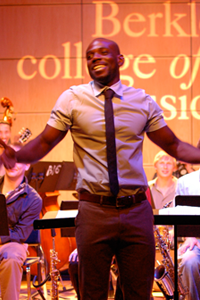Don't see what you're looking for?
Main Site
Berklee.eduCampuses and Schools

Omar Thomas
For media inquiries, please contact Media Relations
Hailed by Herbie Hancock as showing "great promise as a new voice in the further development of jazz in the future," educator, arranger, and award-winning composer Omar Thomas has created music extensively in the contemporary jazz ensemble idiom. Thomas's music has been performed in concert halls across the country, and he has been commissioned to create works in both jazz and classical styles. His work has been performed by such diverse groups as the Eastman New Jazz Ensemble, the San Francisco and Boston Gay Mens' Choruses, and the Colorado Symphony Orchestra, to name a few. His work is featured on Dianne Reeves's Grammy Award-winning album, Beautiful Life.
- Composer, arranger, and trombonist
- A number of celebrated singers perform over his arrangements, including Stephanie Mills, Yolanda Adams, Nona Hendryx, BeBe Winans, Kenny Lattimore, Marsha Ambrosius, Sheila E., Raul Midon, Leela James, Dionne Warwick, and Chaka Khan
- ASCAP Young Jazz Composers Award (2008)
- Jazz Artist of the Year at the Boston Music Awards (2012)
- Thomas's We Will Know: An LGBT Civil Rights Piece in Four Movements was nominated for four OUTMusic Awards
- Lavender Rhino Award (2014), from the History Project, acknowledging his work as an up-and-coming activist in the Boston LGBTQ community
- B.M., James Madison University
- M.M., New England Conservatory
"I use music to teach music. Music theory can be very daunting and frightening to look at, but what it represents is something that is so universal. I'm really about getting past the scary terms, symbols, dots, and lines and getting to what they represent. I'm a huge advocate of talking about not how music sounds but how it feels, to instantly make that connection."
"As a result of my teaching, I hope that students walk around and listen to music in a completely different way and that they feel the music in a different way. I hope that the love and the passion I have is contagious. I hope they see the musical world through different ears."
"I teach the way I do because I think that's the way I learned all of this material. I think about how I made all these connections for myself, through studying classical trombone, studying jazz, and what I did to get to that point. I try to use that to teach my classes. As a composer, all the stuff I put on the board is what I use in my professional work. It's fun for me to go back, make connections, and look analytically at the music."
